Less well-known tourist spots in Japan. 坂本Sakamoto Shiga Prefecture.
After getting off the train, you can walk up the slightly uphill approach to Hiyoshi Taisha Shrine and arrive in the town of Sakamoto. The approach is a modern road with cars running down the middle, but the sidewalks on both sides are paved with stone walls and cobblestones, retaining the atmosphere of medieval Japan.
Old stone lanterns stand in the grass beside the sidewalk, and old cherry and maple trees spread their branches. In spring, the cherry blossoms are in full bloom, and in autumn the maples turn bright red. The trunks of the trees are also covered in moss.
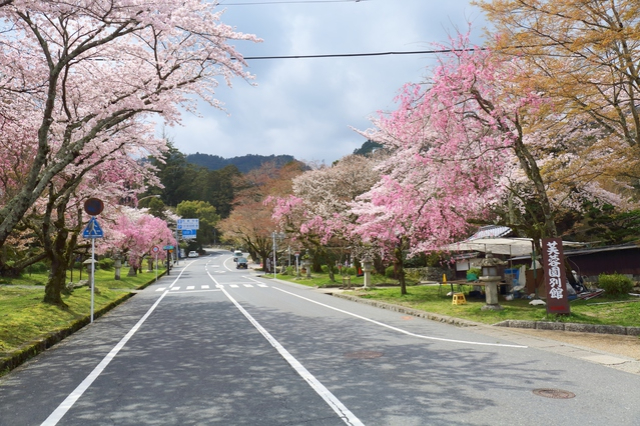
- 1. A town that retains traces of medieval Japan
- 2. Sakamoto is a city with a long history.
- 3. It takes 16 minutes by train from the world-famous tourist destination Kyoto to Sakamoto.
- 4. The streetscape of the Satobo temples – Former Chikurin-in temple is perfect for Instagram
- 5. Saikyouji Temple and Hiyoshi Taisha
- 6. Shigain Monzeki
A town that retains traces of medieval Japan
There are stone walls everywhere in this town. People who were skilled at building stone walls have lived in the nearby village of Anao since ancient times. They had the skills to build sturdy stone walls using natural stones without processing them. They were called the Anoushu and were active from the Muromachi period to the Sengoku period. They were a professional group similar to the mason guilds and masons of medieval Europe.
The stone walls they built were not only sturdy but also beautiful. They gained a reputation as “Anoushu-zumi" and were adopted for many castles and temples. Oda Nobunaga’s Azuchi Castle was also built with Anoushu-zumi. They also built the stone walls of the Satobo in Sakamoto. Satobo is a residence for high-ranking monks who trained at Enryakuji Temple on Mount Hiei and retired from the mountain when they grew old. They built it with faith.
Satobo are lined up on both sides of the approach to the temple, forming a street. The buildings and large gardens are surrounded by stone walls and hedges. Walking along the narrow paths of the moss-covered stone walls of the Satobo, you feel as if time has stopped. There is a silence here that is not found in other tourist destinations.
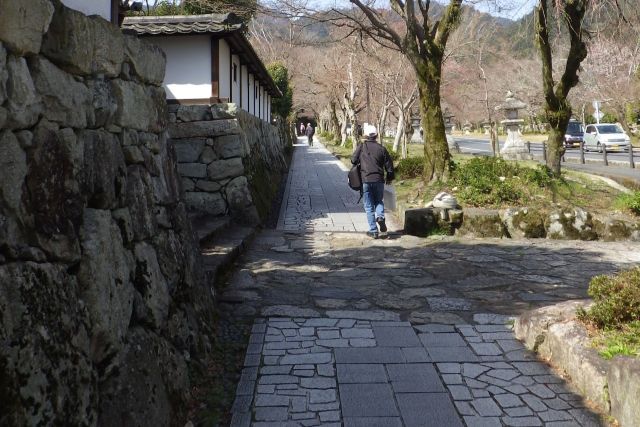
Sakamoto is a city with a long history.
Sakamoto is a town built on an alluvial fan created by a river flowing out of Mount Hiei. It is located on the southern shore of Lake Biwa. Located to the east of Kyoto across Mt. Hiei and facing Lake Biwa, Sakamoto became an important port where goods from the eastern provinces and Hokuriku region gathered. It also developed as a temple town, with the location of Enryaku-ji Temple on Mt. Hiei, Hiyoshi Taisha Shrine, and Saiko-ji Temple.
During the Sengoku period, the 12th and 13th shoguns of the Muromachi shogunate, Ashikaga Yoshiharu and Hosokawa Harumoto, were defeated by Miyoshi Nagayoshi and fled here. During the Azuchi-Momoyama period, Akechi Mitsuhide built Sakamoto Castle, but after Mitsuhide was defeated in the Battle of Yamazaki following the Honnoji Incident, his senior vassal Akechi Hidemitsu set the castle on fire. Copper coins have also been minted in Sakamoto since ancient times. In the Edo period, circulating coins called Kyo-sen were minted. Dutch merchants called Kyo-sen “Sakamoto" and exported them to China and Southeast Asia.
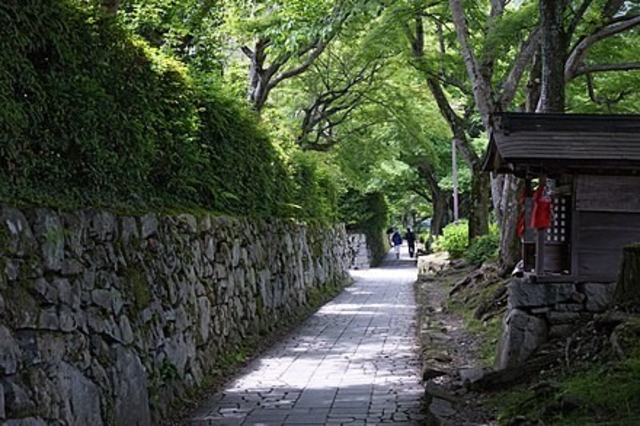
It takes 16 minutes by train from the world-famous tourist destination Kyoto to Sakamoto.
During the Sengoku period, the 12th and 13th shoguns of the Muromachi shogunate, Ashikaga Yoshiharu and Ashikaga Yoshiteru, and Hosokawa Harumoto, fled here after losing a battle against Miyoshi Nagayoshi.During the Azuchi-Momoyama period, Akechi Mitsuhide built Sakamoto Castle, but after losing the Battle of Yamazaki, his senior vassal Akechi Hidemitsu set the castle on fire. This historic town is just a short distance from tourist-filled Kyoto.
It takes 16 minutes on the Kosei Line from JR Kyoto Station to Hieizan Sakamoto Station, and costs 320 yen. Modern transportation has made this distant town on the other side of Mount Hiei surprisingly close. If you take the Keihan Railway, you can take the Tozai Line from Sanjo Keihan to Biwako Hamaotsu Station, then transfer to the Keihan Ishiyama Sakamoto Line and go to Sakamoto Hieizanguchi Station. This route takes about 35 minutes because the Ishiyama Sakamoto Line only stops at every station.
The small train stops at tourist spots such as Miidera, Anato, and Matsu no Baba. The fare is also expensive at 570 yen, but if you want to enjoy your trip, this is the way to go. You can also walk about 5 minutes from JR Otsukyo Station to Keihan Hamaotsu Station, transfer to the Ishiyama Sakamoto Line, and enjoy the area along the line. From Sakamoto-Hieizanguchi Station, you can reach Ishiyama-dera Temple, famous for Murasaki Shikibu, in about 30 minutes. It would be fun to go and see Murasaki Shikibu while sightseeing in Sakamoto.
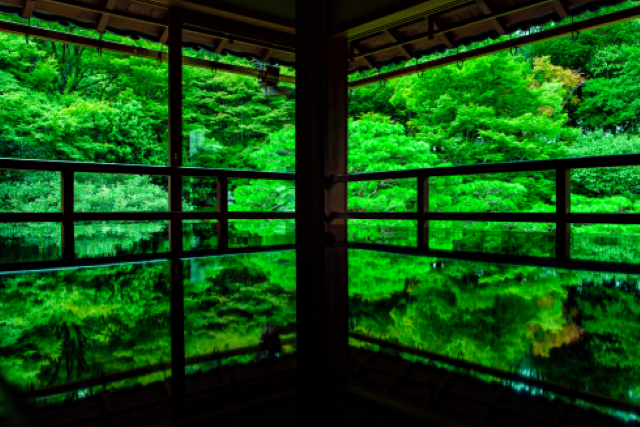
The streetscape of the Satobo temples – Former Chikurin-in temple is perfect for Instagram
The highlight is the Satobo. There are more than 50 Satobo in Sakamoto. There is a gate facing the road, and it is surrounded by stone walls, walls, and hedges made in the style of Anato-shu-zumi. Inside there is a garden and a building in a secluded area. The Satobo have meditative names such as Shikan-in, Eko-in, and Ritsu-in, as they are the homes of high-ranking monks. This historical landscape has been designated an Important Preservation District for Groups of Traditional Buildings by the Agency for Cultural Affairs.
The Satobo gardens are spacious and wonderful. The garden of the former Chikurin-in is set on a vast site, with a hill built with Mount Hachioji as a backdrop, and a meandering stream and waterfalls that draw water from the Omiya River. The quiet presence is soothing to the soul, and recently it has also become a popular Instagram spot. It seems that the greenery of the garden reflected in the low table is striking.
Saikyouji Temple and Hiyoshi Taisha
There are many other things to see. Hiyoshi Taisha is the head shrine of the Sanno-san, which has over 3,800 shrines nationwide. The grounds are spacious with clear streams running through them, and there are few people around, creating a mystical atmosphere. The main halls of the national treasures, the East and West Main Shrines, the Hiyoshi Sanbashi Bridge, said to be the oldest stone bridge in Japan, and the Saruishi stone, which resembles a sitting monkey, are highlights.
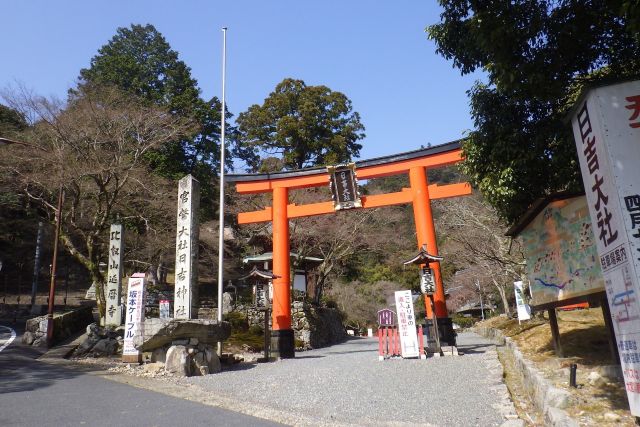
The shrine is located in the front demon gate of Heian-kyo. It has protected the Imperial Palace as the guardian deity of Kyoto since the Heian-kyo period. It was also worshiped as the guardian deity of Enryaku-ji Temple on Mount Hiei. The messenger of the god here is a monkey. This is because monkeys are associated with “evil goes away" and “victory." There is also a wooden carved monkey on the corner of the demon gate wall of the Imperial Palace in Kyoto. This place is also famous as a famous spot for viewing maples, and it is lit up at night in the fall.
Saikyo-ji is the head temple of the Tendai Shinsei sect. It is said to have been founded by Prince Shotoku. In the Muromachi period, after the monk Jie Daishi Ryogen restored the dilapidated temple, the monk Shinsho restored the temple buildings and teachings, making it a training center for precepts and nembutsu. The stately main hall, made entirely of zelkova, houses a 「Zyoroku Amida Buddha」, an Important Cultural Property.
The guest hall was relocated from the palace of Fushimi Momoyama Castle, and many Kano school paintings, as well as portraits and floral and bird paintings on the sliding doors remain. There are four gardens, including the guest hall garden designed by Kobori Enshu, which makes clever use of the slope of the mountain behind the temple, allowing visitors to enjoy the nature of the four seasons. This temple is also associated with Akechi Mitsuhide. Mitsuhide worked hard to restore the temple, which was burned down when Nobunaga burned down Mount Hiei. The graves of Mitsuhide’s wife, Teruko, and his family are located within the temple grounds. The view of Lake Biwa from the mountain gate is beautiful. I wonder if Mitsuhide also saw it.
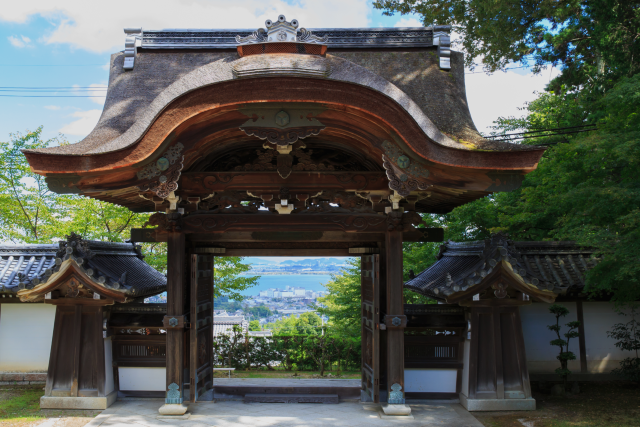
Shigain Monzeki
Shiga-in Monzeki was relocated from Hossho-ji Temple in Kitashirakawa, Kyoto, by Tenkai Daisojo, a secret advisor to Tokugawa Ieyasu. The temple boasts a high status, with a member of the imperial family serving as the head priest of Tendai until the end of the Edo period. The vast grounds are surrounded by stone walls made of “Anoushu-zumi", and include a shoin study with Kano school screen paintings from the early Edo period, as well as a wonderful garden with stonework, plantings, waterfalls and stone bridges, said to have been created by Kobori Enshu.
There is a theory that Tenkai Sojo’s true identity is Akechi Mitsuhide, who is supposed to be dead. This is supported by his handwriting and the Chinese bellflower crest. It makes you think that Tenkai Sojo might have supported Sakamoto, who was associated with Akechi Mitsuhide. Other points of interest include Hiyoshi Toshogu Shrine, Ritsuin Temple, and Jigen-do Hall. If you have time, why not take the cable car to Enryaku-ji Temple at the top of Mount Hiei?
Kyoto’s tourist attractions are all packed with people. If you don’t want to be surrounded by crowds, why not take a trip to Sakamoto and enjoy the silence? It’s nice to spend half a day in a medieval town that changes its appearance with each season, with cherry blossoms in spring, greenery in summer, autumn leaves in fall, and white snow in winter. If you get hungry, try some tempura soba at Tsuruki, a 300-year-old soba restaurant, and your trip to Sakamoto will be complete.

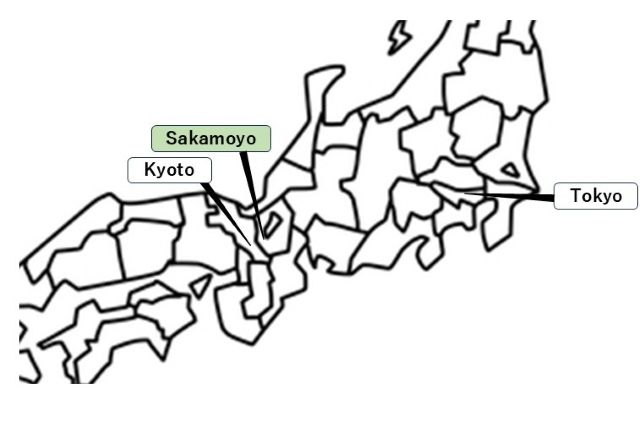
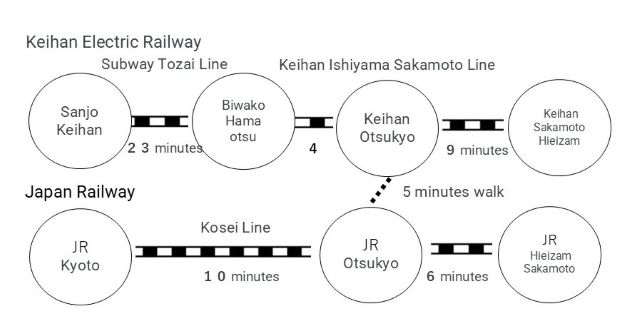
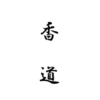
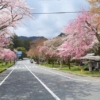





ディスカッション
コメント一覧
まだ、コメントがありません